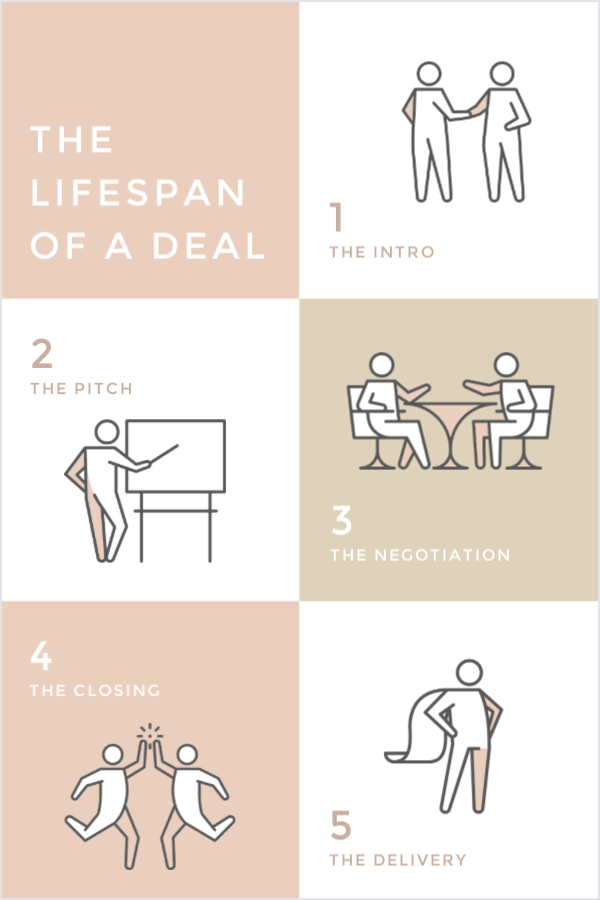
Three years ago Tia Meyers was laid off from her corporate job in social media, so she decided to try working for herself by offering her social media strategy skills to private clients. Today, this founder of Freelancing Females (an international community of 190,000 women who work for themselves) hasn’t looked back since, and along the way she’s learned many lessons that she freely shares with other women who freelance, or want to start.
In a webinar hosted by PicMonkey’s Hannah Dron, Tia explains how to get paid as a freelancer—arguably the most important aspect of working for yourself. To get from A to $, Tia says that understanding the lifecycle of a deal will increase your chances of finding good clients, negotiating the fees you want, and then closing the projects on a positive note.
The lifespan of a freelancing deal: 5 steps

Step 1: The Intro
Be aware of your online and public presence because it’s your first introduction to potential customers—they’re checking you out before they ever communicate with you. Does your website and all the links within it function correctly? Is your email working? Does your public social media reflect your professional brand?
When someone reaches out to you (or you to them), try to schedule a real conversation as soon as possible so you can gauge their seriousness, understand the scope of their project, and learn if the work will be worth your time.
Step 2: The Pitch
Your IRL meeting is approaching, so prepare for it by researching the person online—learn about their business and their alma mater, of course, but also try to glean small personal things to help you connect. Do they like kitesurfing or dogs, for instance? Read any interviews they’ve given or essays written by or about them, because these may contain clues to their pet peeves and their favorite things.
When you meet in person (or video chat), strive for authenticity and professionalism as you present what you have to offer them. Have a real conversation asking lots of questions, mirroring their body language, and listening well. Learning about them will make them more likely to do business with you because they will feel heard and seen. Do try to get to a “no” as soon as possible, however—you need to know what you’re working (or not working) with so you can move on to the next step: negotiation.

Tia says to remember that confidence is key—you need to believe in yourself—and in your prices.
Doing the deal step 3: Negotiation
Perhaps the hardest part of the deal-doing is talking money. This step is where confidence really comes into play. As you state the number you want to charge for the project, you must convey a sense of capability, firmness, and professionalism so they know you’re good at what you do and you will deliver what you say you will.
When negotiating, always start with your highest number, says Tia. She also recommends using an “odd” number like “$1879” instead of “$1900” because it sounds like you’ve carefully thought about how to value the work. If they balk, follow up with: “What amount are you trying to keep this under?” to determine if you can continue negotiating. Also have a price in mind that you will not go under so you don’t end up selling yourself short.
If they don’t balk at your price, keep in mind that could be a sign that you are charging too little and keep that info in your back pocket for next time you sit at the negotiating table.
When talking with your potential new client, repeat back the last phrase they said when starting your reply (Them: “I really like the colors green and gold.” You: “Green and gold, that is a great combination.”)—again, this will make them feel heard and understood. Also, be quiet, listen to what they have to say, and don’t feel the need to fill up any silence with chatter—they may be doing math in their head!
Doing the deal step 4: The Closing
When you arrive at a mutually agreed upon fee and scope of work, you’re ready to close! (If you can’t come to terms, though, just remember that no deal is better than a bad deal, Tia says.)
Let’s talk about contracts! Contracts are very important and you should never close a deal without one—they help guarantee getting paid on time. FreelancersUnion.org has simple contract templates that you can use to draw up your terms. Tia also recommends adding specifics to the contract so that your client has clear expectations about working with you. Let your clients know your available work hours to discourage 10pm calls on the weekend, also include the scope of work that you’ve agreed to so you can refer back to your contract to point out that any additional work they ask for will cost additional fees. You can also include your payment terms in the contract: do you want part up front? If they are late in paying, will you charge interest? Do you take checks, or prefer direct deposit? The more you define ahead of time, the less unpleasant surprises there will be later.
One last word on the closing step: What should you do with a potential client who says they want to hire you, but then doesn’t return the contract or any of your calls? Tia says asking them this question give you a 81% chance of getting a response: “Have you given up on this project?”
Doing the deal step 5: Delivering finished work
As you complete work on the project, try not to over-deliver or “fall prey to scope-creep,” cautions Tia. Deliver what you agreed upon, and be timely, transparent, and true to yourself. If you do end up doing a little extra, make sure they know it. And if your client wants even more, tell them that you can provide these services for an additional cost.
When you’ve handed off the work, thank your client for their business and ask for feedback so that you can improve your workflow in the future. Be sure to document and archive your work by adding to your portfolio, website, and/or sharing to LinkedIn.
“Once you’ve practiced these strategies and gone through the lifecycle of a deal a few times, it will become like second nature,” says Tia, adding, “and your confidence will grow.”
